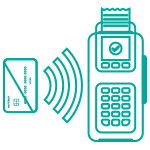Running a business is not a cakewalk, especially when your business is moving at rocket speed. If you are a retailer, you must use an electronic point-of-sale system for easy business.
For most businesses, cash files used to be great until they had several items to sell. Tracking stock takes a lot of time, and you might need to focus on other critical work.
That’s where EPOS comes into the picture. Now all retailers, irrespective of their size, can manage the stock with seamless information synchronized between the offline store and an eCommerce website.

What is Epos System & How Does it Work?
Basics of EPOS
EPOS is the electronic point of sale system heavily used by businesses today. It’s a perfect blend of hardware and software that provides an efficient business operation. A store owner can process and track the sales with the EPOS system and make the process easy. Furthermore, the store owners can understand the business performance perfectly. With this system, one can provide seamless stock information and connect it to the eCommerce website.
EPOS software
Usage of the EPOS software is the primary key to successful retail management. Having at least one piece of software that aligns with your business needs is essential. After deciding on the best software, you need to choose compatible hardware. Some of the most common software includes different features depending on the specific business needs.
- Tracking and stock control
- Loyalty programs
- Promotions besides discounts
Some businesses might require different or additional functions to align with their specific requirements. Several system suppliers know the requirements and offer a scalable system that aligns with business growth. They might also provide customization services to ensure a perfect solution.
EPOS hardware
Depending on the specific requirements, the companies might wish to have different hardware elements.
The main hardware element consists of a terminal screen. This is where a business can put its orders and process payments in place. In the past few years, the price of touch screen monitors has significantly reduced and has become cost-effective for all retailers. The touch screen display allows quick data entry at the point of sale and removes the need for a keyboard. The additional hardware elements are connected through cables or wirelessly.
Barcode scanner
A barcode scanner is an electronic scanner that reads the bar codes to identify product details on the EPOS system. Various types of barcode scanners are available, but one of the most common ones is the handheld and multiline. The multiline scanners can read barcodes, which speeds up the process. They are perfect for places with a high volume of transactions. On the flip side, handheld barcode scanners are used with minimum transaction volume.
Customer display
It is a device to deliver price and advertising information to clients at the point of sale.
Tablet or iPad
It is hardware that is used instead of the typical EPOS that helps with the business operation. It is perfect for businesses requiring better mobility or small stories with minimum space—for instance, mobile vendors, gift shops, quick-service restaurants, juice bars, etc.
How does EPOS System work?
Like your cash register, the EPOS works similarly and is connected to the computer. The system will read the product barcode through a barcode scanner and calculate the amount a customer needs to pay.
It offers accurate pricing information while offering seamless service to the buyers. The software records sales updates, stock levels, and customer data in the backend.
Later, the store owner can extract various types of reports anytime. These reports reflect the actual business performance and help in quick decision-making.
With EPOS, the process has become very automated, giving the seller 10x more visibility compared to what it used to provide them with analytics.
Advantages and disadvantages of EPOS:
Advantages:
EPOS system has different benefits, especially in the long term:
For customers:
- It ensures perfect product pricing information on multiple channels.
- Speeds up the processing of transactions and orders.
- Allows customers to use promotions or discounts online and offline.
- Delivers a seamless and convenient shopping experience through multiple payment options.
For owners:
- Centralize the business operations beside multiple-scale channels from one place.
- Make an accurate and better forecast for inventory.
- Keep track of business performance to provide better insight.
- Reduce the time and mistakes in the manual process.
- Allow correct instant and easy updates for data.
Disadvantages of EPOS:
The primary disadvantage to EPOS is the cost, especially the upfront cost, which can be a huge put-off for small businesses.
Difference between POS and EPOS:
POS is the point of sale where customers can easily make payments while buying products or services. Customers make a point of the sale transaction whenever they make a purchase.
In the previous days, cash registers were used, but not with time; EPOS has taken over, which now handles automated transactions.
On the flip side, EPOS systems accept online payments, credit card payments, and debit cards, allowing you to take a closer look at your business and its running. EPOS systems are known to be the modern or electric version of traditional POS systems, which entirely operate online.
Why should you choose a modern EPOS?
EPOS offers better security protocols than the typical POS systems, which is essential as they are web-based. The heightened security offers better protection and reduces the risk of hackers resulting in data loss. EPOS offers flexibility regarding payment options and is also equipped with analytical tools. Typical POS systems accept cash, credit cards, and debit card payments.






![What is Stock Audit? [How to Perform It & Its Advantages]](/wp-content/uploads/2022/12/Blog_Image_700x400_68-500x383.jpg)


![How to Start Catering Business [Ideas, Plan & Item List]](/wp-content/uploads/2022/09/8b78cc_08060cb445e048ecb631cb39802cb5f7_mv2-500x383.webp)
Leave A Comment